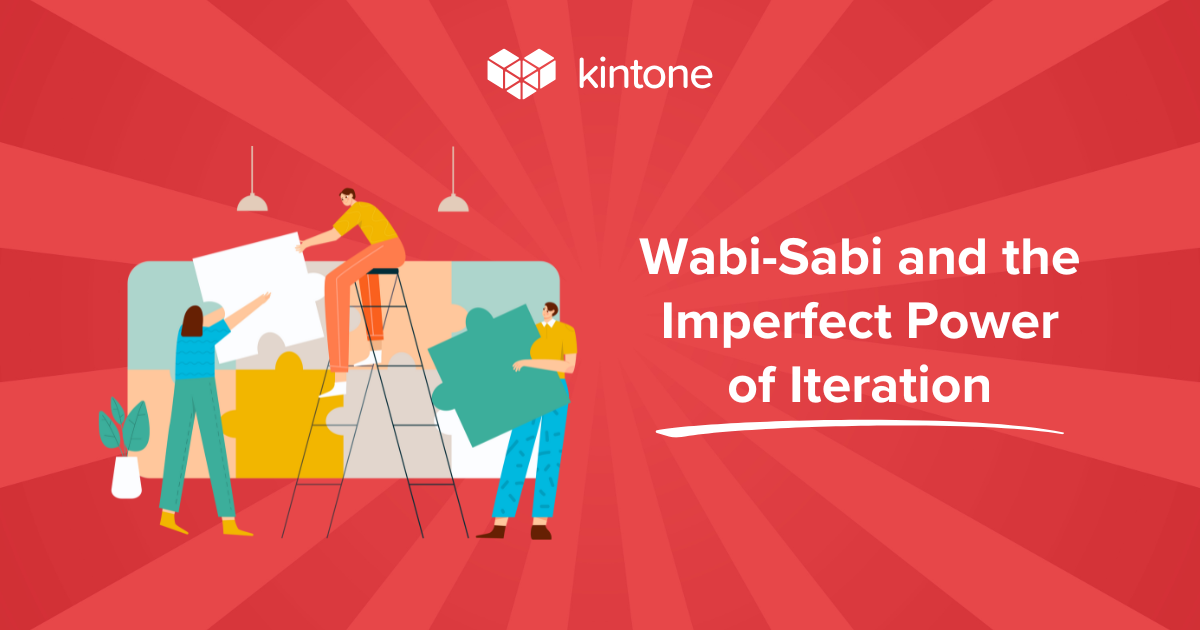Key Highlights
-
Kaizen boosts productivity even when only modestly practiced.
-
Manufacturers and hospitals saw measurable gains through Kaizen.
-
Small businesses can apply lean principles at a low cost.
-
Barriers like poor training and weak leadership can be mitigated through structured support.
-
Kintone enables Kaizen by helping teams document, test, and scale improvements.
Small Tweaks Lead to Big Wins with Kaizen
Imagine if every day your team made one small adjustment that made work just a bit easier.
Over time, those tiny changes would add up to something substantial—more efficient processes, more satisfied customers, and far less friction.
That’s the essence of Kaizen, the Japanese philosophy of continuous improvement. Meaning “change for the better,” Kaizen encourages every team member to identify and resolve inefficiencies in real time, rather than waiting for a full-scale overhaul.
What makes Kaizen especially powerful is its accessibility. According to recent research published in Transactions on Engineering and Management, Kaizen implementation—when supported by leadership and rooted in employee engagement—has a significant, positive effect on productivity, quality control, and organizational performance. In the study, 78% of respondents noted measurable improvement in work culture and output when Kaizen was properly applied.
Because it relies more on mindset than budget, Kaizen is ideal for organizations of any size. It doesn’t require specialized certifications or tools to get started—just a willingness to look at processes critically and improve them step-by-step.
And as employees begin to experience the results of their efforts, confidence builds. What starts as a small tweak becomes a culture of innovation. Kaizen can also be combined with other improvement frameworks, like Lean or Six Sigma, making it a flexible strategy for sustainable growth.
🚀 See how small changes can drive big results — talk to a Kintone specialist
What is Kaizen and Why Does Continuous Improvement Matter?

At its heart, Kaizen is a mindset of constantly looking for ways to do things better – one small step at a time. Rather than drastic, one-off innovations, Kaizen encourages ongoing, everyday improvements by the people doing the work.
No improvement is too small: cleaning up a confusing form, streamlining an approval step, reorganizing a file directory – it all adds up. Over time, these continuous tweaks eliminate waste (“muda” in lean lingo) and inconsistencies, making processes more efficient and effective.
Crucially, Kaizen is inclusive: it involves everyone from frontline employees to managers in brainstorming ideas and solving problems. This collaborative approach not only improves workflows but also boosts team morale and skill growth.
By making improvement a daily habit, organizations become more agile, productivity climbs without hefty investments, and work becomes less frustrating and more “in flow.” In short, Kaizen is about working smarter, not harder – and having a culture that never settles for “good enough.”
Small Changes, Big Results: Kaizen in Action Across Industries
Manufacturing: Precision, Efficiency, and the Power of Process Innovation
Kaizen has long been a cornerstone of manufacturing, where small improvements can lead to big payoffs in quality, speed, and consistency. In fast-moving environments, even minor process tweaks can result in dramatic gains.
A study on a reusable metal-based tool used in chemical manufacturing (Kumbhar et al., 2022) offers a great example. Researchers found that by using a tool designed to be recovered and reused multiple times, they reduced waste and improved efficiency without compromising performance (Kumbhar et al., 2022). It’s a simple yet powerful reminder that smart reuse and process refinement can make a meaningful difference.
While the study centers on chemistry, the core message mirrors Kaizen thinking: small, consistent improvements—whether in tools, workflows, or systems—can drive sustainable success. It’s about making things just a little better, every day.
In manufacturing, Kaizen isn’t about overhauling everything at once. It’s about building momentum through practical changes that compound over time. Whether it’s improving a production method or reorganizing a workspace, the goal stays the same: reduce waste, work smarter, and keep raising the bar.
Healthcare: Treating Process Pain Points for Better Care
In healthcare, where efficiency and accuracy are critical, Kaizen offers a powerful framework for improving patient care and operational performance. From admissions to discharge, small process refinements can create significant ripple effects across an entire facility.
A study published in the Journal of Business Management and Innovation examined the use of Kaizen in hospitals and found measurable benefits across both patient outcomes and staff satisfaction. Specifically, it highlighted how Kaizen helped reduce patient wait times, improve interdepartmental communication, and eliminate unnecessary steps in patient handling processes (Azeem et al., 2022).
One hospital in the study saw notable improvements after implementing staff-led Kaizen projects focused on reducing diagnostic delays and streamlining patient flow. Teams introduced visual management tools, restructured handoff procedures, and eliminated redundant documentation—all resulting in faster turnaround times and more engaged personnel.
The research confirms that when Kaizen is applied to targeted pain points using tools like the PDCA (Plan-Do-Check-Act) cycle, healthcare systems can improve not just efficiency, but also safety and quality of care. However, the study also emphasizes that long-term success depends on leadership support, continuous training, and a culture that encourages every employee to contribute ideas for improvement.
In short, Kaizen helps healthcare teams do more than treat symptoms—it empowers them to improve the system itself, one small step at a time.
Overcoming Kaizen Implementation Challenges (and Making It Stick)
Barrier: Lack of Training
Many Kaizen efforts falter from insufficient training (Shatrov et al.).
Success Factor: Provide education on lean methods like PDCA and 5S. Workshops and hands-on coaching build confidence and practical skills.
Barrier: Weak Management Commitment
Kaizen fails without leadership buy-in. SMEs often lack sustained management support (Shatrov et al.).
Success Factor: Leaders must model Kaizen, set aside time for it, and publicly recognize employee contributions.
Barrier: Resistance to Change
Skepticism and fear of job loss can hinder adoption.
Success Factor: Involve employees early. Use cross-functional teams, celebrate wins, and emphasize Kaizen’s job-supporting (not job-cutting) purpose.
Barrier: Sustaining Momentum
Even after initial improvements are made, sustaining momentum can be difficult. Teams often have the best intentions to continue optimizing workflows, but day-to-day responsibilities tend to take over, and improvement initiatives lose steam.
That’s where working with a Kintone consultant can make all the difference. A consultant who understands Kaizen and Lean methodologies can help keep initiatives on track by outlining clear action items, collaborating with stakeholders, and ensuring accountability throughout the process. With this kind of support, your team can turn one-time wins into lasting progress.
Success Factor: Document changes, update SOPs, assign owners, and schedule regular Kaizen reviews to maintain momentum.
Kaizen must itself be an evolving process.
Accelerating Continuous Improvement with Kintone’s Digital Platform
Kintone is more than a digital tool—it’s a Kaizen enabler. With its customizable app builder, real-time data tracking, and collaborative features, Kintone offers a user-friendly platform that transforms abstract improvement goals into concrete, measurable change. Here’s how it supports your Kaizen journey:
Centralize and Streamline Processes
Kintone allows you to map and digitize workflows with drag-and-drop ease, creating custom apps tailored to how your team actually works. You can visually lay out processes, spot redundancies, and build automations to eliminate repetitive manual tasks—no development experience required. This centralized visibility ensures smoother handoffs, quicker approvals, and easier tracking of tasks across departments.
Empower Every Team Member
Use a dedicated “Kaizen Ideas” app in Kintone to capture insights from every corner of your organization. Whether someone notices a lag in the invoice process or thinks of a better way to tag incoming support tickets, their ideas can be submitted, reviewed, and implemented right within the platform.
Comments, upvotes, and discussion threads help refine and prioritize submissions, turning your team's collective intelligence into continuous value. Colleagues can comment and upvote ideas, creating a collaborative improvement space.
Track Metrics and Outcomes
Kaizen requires feedback loops, and Kintone delivers. You can design custom fields in your apps to monitor everything from cycle times and customer satisfaction scores to defect rates and completion times. Built-in dashboards visualize trends and allow teams to see how a change is performing at a glance.
Adapt and Scale Across Teams
With Kintone, successful Kaizen initiatives don’t live in silos. If a finance team builds an app that cuts invoice processing time in half, that same framework can be adapted by procurement or HR with just a few tweaks. Because all Kintone apps are modular and easily customizable, you can replicate improvements across departments—scaling your wins and creating consistency without limiting flexibility. Kintone makes continuous improvement scalable and shareable.
Embrace the Kaizen Journey
Kaizen is a mindset. Small, consistent changes add up to big gains. Whether you’re in manufacturing, healthcare, or a startup, continuous improvement leads to happier teams and better results.
The journey starts with leadership, participation, and a platform like Kintone to support the process. Begin with that 1% improvement today. A year from now, those small steps could transform your entire workflow.
TL;DR
Pressed for time? Here's a quick snapshot of what you'll take away from this guide:
- Kaizen means small, continuous improvements that build over time.
- It’s effective in manufacturing, healthcare, and small businesses alike.
- Barriers like lack of training or resistance can be overcome with education and leadership support.
- Tools like Kintone make it easier to centralize workflows, track improvements, and sustain progress.
- A Kaizen mindset leads to better work, better culture, and better results.
About the Author
Aisha Moktadier is the President and Lead Consultant at ZAIRA Creative, a boutique consultancy that helps brands grow through intentional storytelling, content, and digital strategy. With over 12 years of experience across healthcare, wellness, tech, and consumer industries, she specializes in turning complex ideas into campaigns that resonate, convert, and endure. When she’s not working, you can find her thrifting around Tampa Bay, reading a good book, or baking a mean English shortbread cookie.




.png?width=730&height=219&name=Ready%20to%20Streamline%20Your%20Workflow%20Create%20Custom%20Apps%20in%20Minutes%20(1).png)






